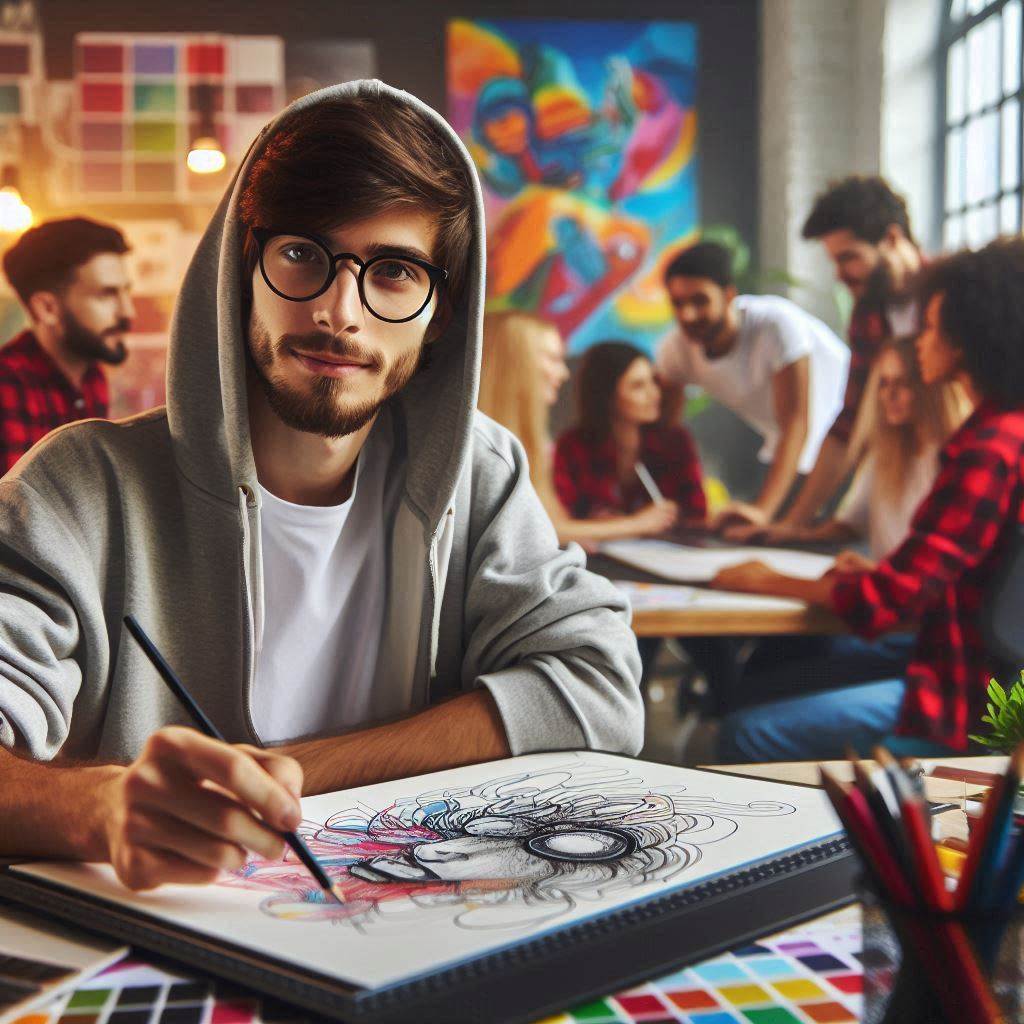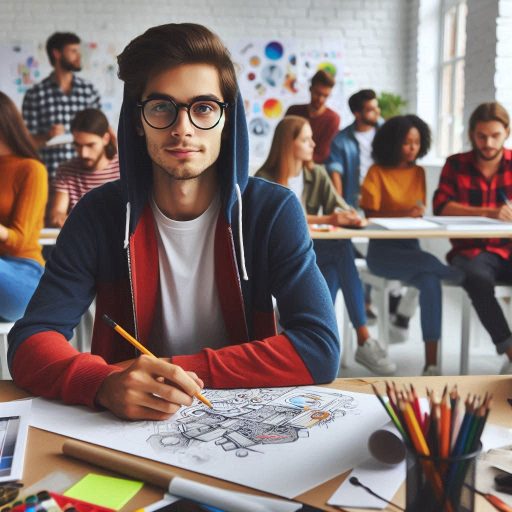Introduction
Artist burnout drains creativity and passion.
It often stems from excessive pressure, lack of inspiration, or monotonous routines.
Recognizing the signs of burnout is crucial for every artist.
Common symptoms include fatigue, frustration, and a feeling of detachment from your work.
Staying creative is vital for artists.
Creativity fuels artistic expression and drives personal growth.
When artists feel inspired, they produce more engaging work.
This, in turn, resonates with audiences, strengthening connections and enhancing their reputation.
Moreover, maintaining creativity fosters resilience.
Artists can adapt to challenges and overcome obstacles more effectively.
A vibrant creative practice promotes mental well-being, allowing artists to explore new ideas and techniques.
It‘s essential to cultivate an environment that nurtures creativity.
This involves setting aside time for exploration and experimentation.
Engaging in diverse artistic activities can rejuvenate your creative spirit.
Ultimately, prioritizing creativity not only combats burnout but also enriches the artistic journey.
By embracing creative habits, artists can sustain their passion and continue to thrive in their craft.
Balancing productivity with creativity will lead to lasting fulfillment and success in the art world.
Identify Your Triggers
Recognize What Causes Burnout for You Personally
To stay creative and avoid burnout, start by identifying what triggers your exhaustion.
Everyone has unique stressors, and it’s important to understand yours.
Reflect on the moments when you‘ve felt drained, overwhelmed, or uninspired.
These are signs that burnout might be creeping in.
By recognizing what causes your creative energy to wane, you can take proactive steps to avoid it in the future.
Reflect on Past Experiences of Burnout
Think back to times when you‘ve faced burnout in the past.
What led you to that point? Was it an overload of projects, lack of variety in your work, or maybe external pressures?
Reflecting on these experiences can offer valuable insights into patterns that might repeat.
Perhaps you were juggling too many deadlines, or maybe the work itself didn‘t feel fulfilling anymore.
Being honest about your past experiences will help you pinpoint where things went wrong and how to avoid similar situations in the future.
Make a list of potential triggers to be aware of
Once you‘ve reflected on your past experiences, make a list of potential triggers.
This could include tight deadlines, difficult clients, or long hours without breaks.
It might also include internal pressures, like perfectionism or fear of failure.
By putting these triggers on paper, you create a clear roadmap of what to watch out for.
Understanding these triggers allows you to implement strategies to manage them before they lead to burnout.
While personal habits play a significant role, external factors also contribute to burnout.
External stressors, like financial pressures, client demands, or lack of support, can slowly drain your creative energy.
By recognizing these outside forces, you can establish boundaries to protect yourself.
Consider setting limits with clients or scheduling time for self-care.
These steps are crucial for preserving your mental well-being and sustaining your creativity.
Pay Attention to Early Warning Signs
Burnout doesn‘t happen overnight.
It‘s a gradual process that builds up over time.
Pay attention to early signs, like feeling irritable, fatigued, or losing interest in projects that once excited you.
These are signals that something needs to change.
When you notice these signs, don‘t ignore them.
Take a break, slow down, or reassess your workload.
Catching burnout early is essential for maintaining long-term creativity and passion.
Adapt Your Environment to Reduce Burnout Risks
Your environment can either support or hinder your creativity.
A cluttered workspace, constant interruptions, or a toxic work culture can exacerbate burnout.
If these environmental factors contribute to your stress, take steps to change them.
Organize your workspace, seek out supportive communities, and create an environment that nurtures your creative flow.
This will make it easier to stay inspired and avoid burnout in the future.
By identifying and addressing your personal triggers, you‘ll take control of your creative well-being.
Read: Visual Merchandiser: Job Market and Opportunities
Set boundaries
Establish Clear Work Hours and break times
Setting boundaries is essential for maintaining creativity and preventing artist burnout.
By establishing clear work hours, you can create a structure that enhances your productivity.
Determine specific times for starting and finishing your work each day.
Stick to these hours consistently.
When you finish your workday, give yourself permission to relax.
This separation between work and personal time allows your mind to recharge.
In addition to setting work hours, it‘s important to schedule breaks throughout your day.
Breaks help you reset your focus and inspire new ideas.
Consider incorporating short breaks every hour.
Use this time to stretch, grab a snack, or take a quick walk.
After longer work sessions, take more extended breaks.
Use these breaks to engage in activities that you enjoy.
These moments of rest can significantly boost your overall creativity.
Learn to say no to projects that overwhelm you
Learning to say no is another crucial aspect of boundary-setting.
As artists, we often feel pressure to take on every project that comes our way.
However, not every project aligns with your goals or interests.
Evaluate each opportunity carefully.
If a project feels overwhelming or does not excite you, don‘t hesitate to decline it.
Saying no protects your time and energy, allowing you to focus on what truly matters to you.
Create a balance between work and personal life
Creating a balance between work and personal life is vital for sustaining creativity.
It‘s easy to become consumed by your artistic pursuits.
When this happens, your personal life can suffer, leading to burnout.
Set aside time each week for personal activities that nourish you.
Spend time with family and friends, pursue hobbies, or simply relax.
These activities can provide fresh perspectives and fuel your creativity.
Consider implementing a routine that includes both work and leisure.
Create a weekly schedule that allocates specific days for projects and relaxation.
This structure helps you maintain a healthy balance.
You‘ll find that dedicating time to personal interests enhances your creativity during work hours.
Remember that creativity thrives in a healthy environment.
When you respect your boundaries, you give yourself the space to innovate.
A clear distinction between work and personal time allows you to recharge and explore new ideas.
It‘s important to recognize when you‘re feeling overwhelmed and to adjust your workload accordingly.
Pay attention to your mental and emotional state, and prioritize your well-being.
Setting boundaries is essential for staying creative and avoiding burnout.
Establish clear work hours and scheduled breaks.
Learn to say no to projects that don‘t serve you.
Create a balance between your work and personal life.
By respecting these boundaries, you will enhance your creativity and maintain your passion for art.
Read: Networking Events for Costume Designers
Practice self-care
As an artist, your creativity thrives when you take care of yourself.
Prioritizing your physical and mental well-being is essential for staying inspired and avoiding burnout.
By making self-care a priority, you fuel your creative energy and maintain a healthy balance.
Prioritize Your Physical and Mental Well-Being
Your physical and mental health directly impacts your creativity.
When you feel good, your mind can wander freely, leading to new ideas.
Conversely, neglecting your well-being can stifle inspiration and make creativity feel like a chore.
To counteract this, develop a routine that includes regular check-ins on your mental health.
Consider journaling or meditation to reflect on your feelings and stressors.
Incorporate exercise, healthy eating, and sleep into your routine
Exercise is a powerful tool for boosting creativity.
It releases endorphins, which elevate your mood and improve your focus.
Aim for at least 30 minutes of physical activity daily.
Whether you prefer walking, yoga, or dancing, find what works for you.
Schedule this time into your day, treating it as an essential meeting with yourself.
You’ll notice increased energy levels and improved clarity after consistent exercise.
Engage in activities that bring you joy and relaxation
Embrace Healthy Eating Habits
Nutrition plays a crucial role in your overall well-being.
Fueling your body with wholesome foods enhances your creativity and productivity.
Incorporate fruits, vegetables, whole grains, and lean proteins into your diet.
Avoid excessive caffeine and sugar, which can lead to energy crashes.
Consider meal prepping to make healthy eating easier during busy days.
Nourishing your body allows your mind to focus on creating instead of dealing with fatigue.
Transform Your Career Today
Unlock a personalized career strategy that drives real results. Get tailored advice and a roadmap designed just for you.
Start NowPrioritize Quality Sleep
Sleep is often overlooked but essential for maintaining creativity.
Aim for 7-9 hours of quality sleep each night.
Establish a bedtime routine to signal your body that it‘s time to wind down.
Limit screen time before bed and create a calm environment.
This will improve your sleep quality and boost your mental clarity.
A well-rested mind is more open to creative exploration.
Engage in Joyful Activities
Incorporating activities that bring you joy can significantly enhance your creative flow.
Make time for hobbies outside of your art practice.
Explore music, gardening, cooking, or spending time with friends.
These activities recharge your spirit and often inspire new ideas.
Allow yourself to enjoy these moments without guilt.
They are not distractions; they are essential for your creative journey.
Find Relaxation Techniques
Finding ways to relax can help prevent burnout.
Techniques like deep breathing, meditation, or mindfulness can ease tension.
Schedule short breaks throughout your day to reset and recharge.
Use these moments to step away from your workspace and enjoy nature or a good book.
Incorporating relaxation into your routine helps maintain your creativity.
By prioritizing self-care, you create a sustainable approach to your artistic journey.
Focus on your physical and mental well-being, and engage in joyful activities.
These practices will keep your creative spirit alive and help you avoid burnout.
Remember, taking care of yourself is the first step toward nurturing your creativity.
Read: Collaborating with Other Creative Roles
Change your environment
Changing your environment can significantly impact your creativity.
New surroundings often spark fresh ideas.
When you experience different settings, your mind opens up.
You see things from new perspectives, which can ignite creativity.
Seek inspiration in places you wouldn‘t normally go.
Visit art galleries, nature parks, or bustling caf‘s.
Each new environment offers unique sights, sounds, and experiences.
Seek Inspiration from Different Surroundings
Diverse environments enhance your creative thinking.
Visit museums, botanical gardens, or local markets.
Each location provides different stimuli for your senses.
Notice the colors, shapes, and patterns around you.
Engage with the people you meet.
Their stories may inspire new concepts for your work.
Traveling, even locally, can shift your mindset.
Explore nearby towns or hiking trails.
A change of scenery can refresh your ideas and motivations.
Consider how nature influences creativity.
Natural settings often evoke feelings of peace and inspiration.
Use these experiences to inform your creative projects.
Take Breaks and Go for Walks Outside
Taking breaks is essential for maintaining creativity.
Stepping away from your work allows your mind to recharge.
Go for walks outside during your breaks.
Fresh air and movement stimulate your brain.
Walking increases blood flow and oxygen levels, which enhances focus.
During these walks, observe your surroundings.
Notice the small details that you usually overlook.
Pay attention to the rhythm of nature and the sounds of your environment.
This mindful observation can spark new ideas.
Set aside time in your daily routine for outdoor breaks.
Aim for at least 15 minutes each day.
Use this time to clear your mind and reflect.
Enjoy the sights and sounds around you.
Let nature’s beauty inspire your next creative project.
Rearrange Your Workspace to Stimulate Creativity
Your workspace influences your creative output.
An organized and inviting space can enhance productivity.
Rearranging your workspace can create a fresh atmosphere.
Move your desk, change the lighting, or add plants.
Each change can invigorate your environment.
Consider the colors in your workspace.
Bright, vibrant colors can energize your creativity.
Use art and decor that inspires you.
Surround yourself with items that spark joy or motivation.
Keep your workspace clutter-free to minimize distractions.
A clean space fosters clarity and focus.
Personalize your area with photographs or quotes that resonate with you.
These items serve as daily reminders of your goals.
A workspace that reflects your personality encourages creative expression.
Implement these changes gradually.
Experiment with different arrangements until you find what works.
Regularly revisiting and updating your space can keep it fresh and inspiring.
Changing your environment can invigorate your creativity.
Seek inspiration in new surroundings, take regular breaks, and rearrange your workspace.
Each action enhances your creative process.
By embracing these strategies, you can prevent burnout and cultivate a vibrant creative life.
Make small adjustments today and watch your inspiration flourish.
Read: Top Skills Needed for Art Educators and Instructors

Try New Techniques
When it comes to creativity, exploring new techniques can invigorate your artistic process.
Each technique you try opens doors to fresh ideas.
By experimenting with different mediums and styles, you keep your work dynamic.
This experimentation can lead to unexpected breakthroughs.
Experiment with different mediums and styles
Diving into new mediums can reignite your passion for art.
If you usually paint, try sculpting.
If you favor digital art, experiment with watercolor.
Each medium offers unique challenges and opportunities.
You might discover a hidden talent in a style you’ve never tried.
Use materials you have at home or invest in something new.
When you switch styles, you can learn a lot.
For example, if you typically work realistically, try abstract art.
This shift can help you think outside the box.
Embrace mistakes as part of the learning process.
Each error leads you closer to understanding your creative voice.
Challenge Yourself with Creative Exercises and Prompts
Creative exercises can push you beyond your comfort zone.
Set aside time each week for these activities.
Consider daily drawing challenges or weekly painting prompts.
These exercises will keep your skills sharp and your ideas flowing.
Try to create something in a limited time.
Set a timer for 10 or 20 minutes and work on a piece.
This constraint can foster spontaneity and originality.
The pressure can help you bypass your inner critic.
You can also use random word generators for prompts.
Select a word and create a piece that reflects it.
This approach can lead to unexpected interpretations.
Sometimes, a simple prompt is all you need to spark creativity.
Attend Workshops or Classes to Learn New Skills
Learning from others can provide fresh perspectives.
Workshops and classes introduce you to new techniques and methods.
Engaging with fellow artists can be incredibly inspiring.
They can offer feedback and encouragement as you explore new avenues.
Look for local art classes or online workshops.
Many platforms offer a variety of courses in different mediums.
Whether it‘s pottery, printmaking, or digital art, you can find something that excites you.
Don‘t shy away from classes that seem intimidating.
Challenging yourself in this way builds resilience.
You may struggle initially, but growth happens outside your comfort zone.
This struggle can be a vital part of your artistic journey.
Trying new techniques, experimenting with different mediums, challenging yourself with exercises, and attending workshops can rejuvenate your creativity.
These approaches keep your artistic process fresh and exciting.
Embrace change and be open to new experiences.
By incorporating these strategies into your routine, you can avoid burnout and nurture your creative spirit.
Remember, the journey of creativity is just as important as the destination.
Stay curious, keep experimenting, and enjoy the process.
Your next great idea is just around the corner!
You Might Also Like: Motion Graphics Designer: Job Description
Connect with other artists
Connecting with fellow artists enriches your creative journey and helps combat burnout.
Building a community provides a sense of belonging.
When you engage with others, you share insights and inspiration that spark new ideas.
This collaboration fosters growth and creativity, preventing isolation that can lead to burnout.
Join a local art community or online forum
Joining a local art community creates valuable connections.
You meet like-minded individuals who share your passion for art.
Attend workshops, exhibitions, and art fairs in your area.
These events provide opportunities to learn and network.
Engaging in local art groups cultivates friendships and encourages collaboration.
Participating in community events exposes you to diverse perspectives.
You‘ll see different techniques, styles, and ideas.
This exposure can rejuvenate your creativity and motivate you to explore new approaches.
Local art communities often host regular meetings and critique sessions.
These gatherings provide constructive feedback and foster artistic development.
Additionally, local art groups often collaborate on projects.
These collaborative efforts lead to unique artwork that showcases different talents.
Working together creates a sense of accomplishment.
It also builds relationships with other artists, enriching your artistic network.
If local communities aren‘t accessible, consider joining online forums.
The internet connects artists globally, allowing you to share experiences.
Online platforms offer a vast array of discussions on techniques, struggles, and successes.
Engaging in these conversations keeps your creative spirit alive.
Participating in online forums also exposes you to diverse viewpoints.
You gain insights from artists around the world.
This exposure encourages you to experiment with different styles and methods.
Online forums provide a space to share your work and receive feedback.
Constructive criticism helps refine your skills and enhances your creativity.
Furthermore, online communities can be a source of emotional support.
When facing challenges, connecting with others who understand your struggles is invaluable.
Sharing your experiences with fellow artists can ease feelings of isolation.
This support system can uplift you during tough times.
Collaborate with fellow artists on project
Collaboration brings fresh energy to your creative process.
Working with other artists allows you to explore new ideas and techniques.
These partnerships encourage you to step outside your comfort zone.
You might discover new strengths and talents in the process.
Start by reaching out to artists whose work you admire.
Propose a joint project or an art exchange.
These collaborations can result in unique artwork that neither of you could create alone.
They also deepen your understanding of different artistic processes.
Collaboration encourages open communication and idea-sharing.
This exchange can lead to innovative concepts and artistic breakthroughs.
It also reinforces the idea that creativity thrives in community.
When you work together, you celebrate each other‘s successes.
This camaraderie helps combat feelings of loneliness.
Transform Your Career Today
Unlock a personalized career strategy that drives real results. Get tailored advice and a roadmap designed just for you.
Start NowShare experiences and support each other through tough times
Sharing experiences with fellow artists strengthens your bond.
Discussing your challenges helps normalize the struggles of creativity.
Knowing that others face similar hurdles provides comfort.
Celebrate achievements, no matter how small, to foster a positive atmosphere.
Support each other during tough times.
Offer encouragement and advice when someone feels stuck.
This support can make a significant difference in overcoming burnout.
Building these connections creates a nurturing environment for creativity to flourish.
Together, you can navigate the ups and downs of your artistic journey.
Explore Further: Building a Strong Exhibition Design Portfolio
Conclusion
Staying creative and avoiding artist burnout are crucial for long-term success.
A healthy creative flow fuels inspiration and productivity.
Implementing the strategies outlined in this blog will help maintain your artistic vitality.
Schedule regular breaks to recharge your mind and body.
Explore new mediums to spark fresh ideas.
Connect with fellow artists for support and collaboration.
Additionally, practice mindfulness techniques to enhance focus and reduce stress.
Keep a journal to track your thoughts and emotions.
This can provide clarity and direction.
Embrace imperfections; they often lead to unexpected breakthroughs.
For further support, consider joining online communities or workshops.
Websites like Skillshare and Udemy offer courses tailored to artistic growth.
Books like “The Artist’s Way” by Julia Cameron provide invaluable insights and exercises.
Remember, your creativity deserves nurturing and care.
Prioritize your well-being to unlock your full artistic potential.
By embracing these strategies, you cultivate a sustainable creative practice.
Staying engaged and inspired leads to a fulfilling artistic journey.
Commit to nurturing your passion and watch your creativity flourish.




